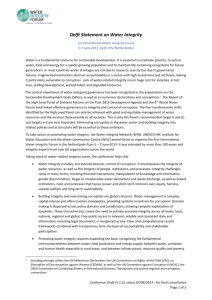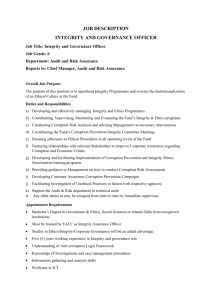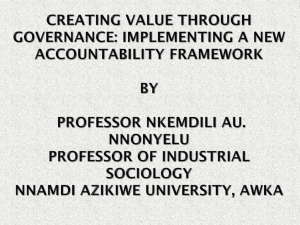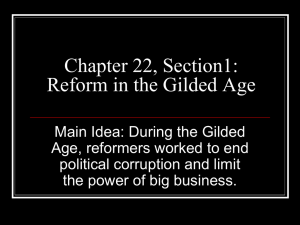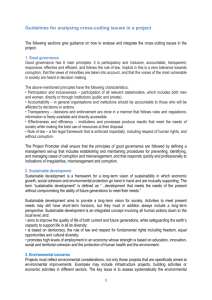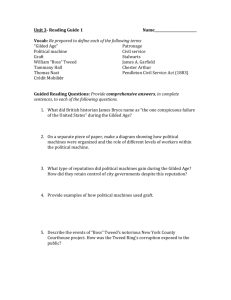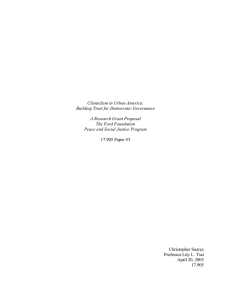Patron-Client Politics and Governance System in Nepal
advertisement
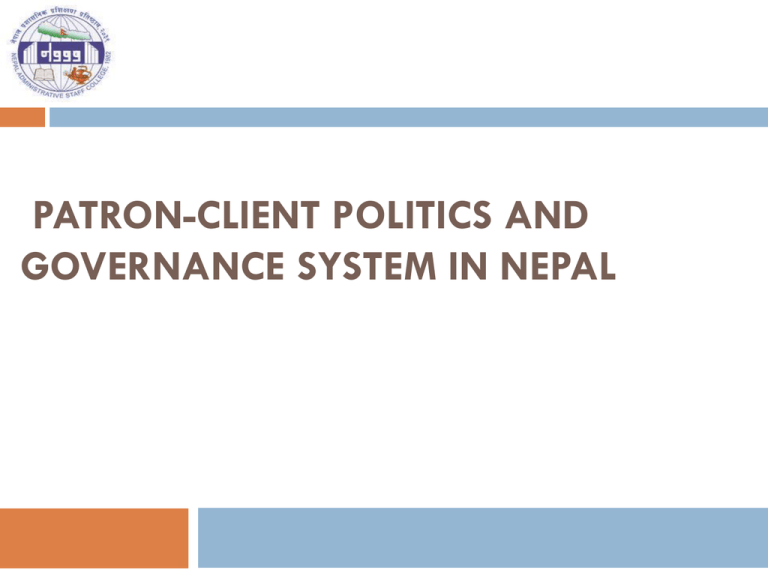
PATRON-CLIENT POLITICS AND
GOVERNANCE SYSTEM IN NEPAL
By:
Shiva Hari Adhikari
Acknowledgements
Government of Nepal
Nepal Administrative Staff College
Seoul National University
Prof. Dr. Kil Kon Ko
Patron-Client Relation
Establishes and promotes informal governance
Creates unauthorized transactions
Holds control over policy decision and implementation
Applies rules with partiality and some citizens get
preferential treatment
Encourages favouritism, nepotism and corrupt practices
“Aafno manchhe” – one’s own people
“Chakari”- serving, offering or appeasing big man
Statement of the Problem
Norwegian Agency for Development Cooperation, 2011
Informal practices more prevalent
Corruption
Bureaucratic and legislative norms to clientelism and patronage
Dix, Hussmann, and Walton, 2012
Patronage system is apparent in society, economy and politics
Corruption
However, both are
Silent on level of patronage
Influence of patronage in governance system
Literature Review
No unique understanding of patron-client relation
The form of patron-client relation may differ across regions
and countries
Patron-client relation as interpersonal exchange and its
negative consequences
Patron-client relation and its not-negative consequences
All levels of patronage are not equally harmful (Dix, Hussmann,
and Walton, 2012; and Johnston, 2010)
Patron-client cluster vs pyramid (Scott, 1972)
Formal and informal governance system (Brinkerhoff and
Goldsmith, 2002)
Framework: Deductive model for
theory construction
Objectives
The general objective of this study is to analyze the
patron-client relation prevailed in Nepal and its
effect on governance system. The specific objectives
are:
to
assess the level of patronage related corruption in
Nepal,
to seek the relationship among the patron-client related
components, and
to evaluate the effect of patron-client relation in the
governance system of Nepal.
Research Question/Hypothesis
R.Q.: What is the effect of patron-client relation in
governance system?
Hypothesis 1: There is a difference in perceived level
of corruption between public officials and students
Hypothesis 2: Higher the patrimonialism is, the more
unfair the civil service will be
Hypothesis 3: Clientelism is positively correlated with
corruption
Hypothesis 4: Patron-client relation worsens the
governance
Methodology
Sample selection: NASC and TU
Research Design: descriptive, explanatory and mixed
Data collection period: 7 – 22 August 2014
Sample size: 106 (public officials), and 167 (students)
Peer review and pretest of questionnaire
Data collection: mixed (questionnaire and face-to-face
interview {2 Students + 3 Public officials})
Data processing: 380 distributed, 324 returned (51 have
quitted or incomplete), 273 fully complete and usable,
85% return rate, 72% response rate
Methodology: Summary of Variables
(newly created)
Type
of Newly Created Number of Items Measurement
Question
Variable
Variable
Included
Number
Poor Governance 5
Five response Likert 211, 212, 324,
Scale
325 and 326
Corruption
6
Five response Likert 201, 202, 206,
Dependent
Scale
and 304 to
306
Unfair
Civil 3
Five response Likert 301 to 303
Service Practice
Scale
Patrimonialism
5 (but after factor Five response Likert 207 to 210,
analysis only 4)
Scale
and 311 (311
is omitted)
Clientelism
7
Five response Likert 203 to 205
Scale
and 307 to
310
Independent
Opaque
5
Five response Likert 312 to 316
Procurement
Scale
Pork Barrelling
3
Five response Likert 317 to 319
Scale
Rent
Seeking 4
Five response Likert 320 to 323
Behaviour
Scale
Methodology: Summary of
Variables
Type of Variable Variable
of Yes/No question
Nominal (Yes=1)
Question
Number
406
Future intention Yes/No question
of bribery
Family member Yes/No question
government
employee
Study group
Yes/No question
Nominal (Yes=1)
408
Nominal (Yes=1)
611
Experience
bribery
Control
Question Type
Family member a Yes/No question
politician
Political
Yes/No question
affiliation
Measurement
Nominal (Public 601
officer=1)
Nominal (Yes=1) 612
Nominal (Yes=1)
613
Methodology
Data analysis:
Mixed
(verbatim and uni-, bi-, and multi-variate analysis)
Inter-correlation and reliability test (Cronbach’s Alpha test)
Factor analysis
Kaiser-Meyer-Olkin measure of sampling adequacy
(>0.5)
Check of the assumptions of the regression model
Findings
Hypothesis 2: Supported as Beta value (0.261) is
positive, and is significant (p <0.01, t = 5.143)
H
y
p
o
t
h
e
s
i
s
3
Hypothesis 4
Hypothesis 1
Summary and Conclusion
All the four types of patronage related corruption –
Influence Market, Elite Cartel, Oligarch and Clan, and
Official Mogul- apparent in society, politics and economy.
Low integrity of state institutions
Tax collection and land management offices are the most
corrupt state institutions.
Low level of public trust
Students- the future leaders- less knowledgeable about
corruption
Public officials- the executors- know less about their code
of conduct
Summary and Conclusion
There are significant percentage of respondents
who believe that patronage related corruption is
tolerable.
About 45% respondents have experienced bribery.
About 72% think that service providers are corrupt.
About 18% have future intention of corruption
About 88% think that ‘chakari/aafno manchhe’ has
helped in promoting corruption in Nepal.
All the hypotheses are significant (except POB
variable)
Policy Implication
Collaborative action: public administration, government,
market and civil society
Service providers: accountable, responsive and ethical.
Promotional action: level of awareness need to be raised
on corruption related matters and issues
Preventive and punitive action: sharp detection mechanism,
robust prosecution and recovery action should be needed
for effective control.
Special mechanism need to be developed and act
immediately to break the tie between patrons and their
clients.
Limitation and Further Research
Respondents:
Public
officials attending a training program at NASC
during 7 to 22 August 2014 (relatively small in size
n=106), however, diverse in working organizations and
years of experience.
Students who have completed Bachelor’s degree, non
probability techniques (snow-ball sampling), may lack
representation, however, diverse in background and
location.
Conflict of Interests: inherent problem of reporting and
perceiving corruption, however, voluntary participation
has helped in reducing response bias
Limitation and Further Research
Governance and Patron-client relation study demands
more in-depth study- direct and indirect observation,
KII, FGD-, study heavily relied on quantitative data
and information, however, qualitative information was
collected through face-to-face interview, and analysis
has been made using verbatim reporting.
Further research should focus on country level analysis
with targeting public officials of all region, I/NGO
officials, politicians (local and national level), service
receivers, private sector, business groups, elites, interest
groups, civil society, and trade unions.
References
Brinkerhoff, D. W. and Goldsmith, A. A. (2002). Clientelism,
Patrimonialism and Democratic Governance: An Overview
and Framework for Assessment and Programming.
Bethesda: U.S. Agency for International Development.
Dix, S., Hussmann, K. and Walton, G. (2012). Risks of
Corruption to State Legitimacy and Stability in Fragile
Situations, U4 Issue, No 3. U4 is a web based reserch
centre: Chr. Michelsen Institute.
Norwegian Agency for Development Cooperation. (2011).
Corruption and Anti-corruption in Nepal: Lessons
Learned and Possible Future Initiatives. Oslo: Norwegian
Agency for Development Cooperation.
